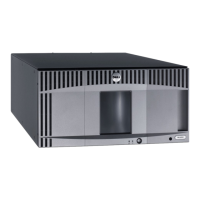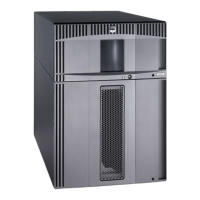Troubleshooting
file:///T|/htdocs/stor-sys/ML6000/en/html/ch09.htm[9/17/2012 1:50:53 PM]
Green AC OK
(top)
• Solid on — The power supply's AC input is above the minimum requirements to operate.
• Solid off — The power supply's AC input is below the minimum requirements to operate.
Green DC OK
(middle)
• Solid on — The power supply's output voltage is within regulation.
• Solid off — The power supply's output voltage is not within regulation.
Blue Standby
(bottom)
• Solid on — Swap mode: Ready to be removed or replaced.
• Solid off — Normal.
In the RAS tickets associated with the defective power supply, record both the number of the module and the number of the
power supply connected to that module.
The 9U Library Expansion Modules are numbered according to their position in relation to the 5U Library Control Module. The
5U Library Control Module is assigned the number 0. All 9U Library Expansion Modules stacked beneath the 5U Library Control
Module are assigned a negative number, while 9U Library Expansion Modules stacked above the 5U Library Control Module are
assigned a positive number. For example, 9U Library Expansion Module -2 is the second 9U Library Expansion Module beneath
the 5U Library Control Module, while 9U Library Expansion Module +2 is the second 9U Library Expansion Module above the
5U Library Control Module.
Each module can have up to two power supplies. The power supply on the left is #1, while the power supply on the right is
#2.
Using the Installation Verification Test
Administrators can run the installation Verification Test (IVT) following a library service action to determine if the library is
ready for production use. Examples of such library service actions include installing a new library or replacing a FRU or CRU.
Note: IVT is optimized for library firmware versions 520G and above and libraries built after July 1, 2008 (serial
numbers with last four digits 8602 and above).
• If your library was built on or before July 1, 2008, and you are running firmware version 520G or above, you will not
be able to run the IVT test, even though the selection is available.
• If your library was built on or before July 1, 2008, and you are running firmware version 500G or below, you can run
the test, but it is not recommended because it may produce erroneous results.
A new IVT Log is created each time you run IVT. The log reports detailed information about library readiness and indicates
where specific marginal conditions and failures are located in the library subsystems if there are any.
The full IVT is divided into five subtests. You may choose to run only certain subtests depending on the amount of time
available and your area of interest. The full IVT may take up to five and one-half hours to complete for a maximum
configured library that includes five modules, five I/E stations and 18 drives.
• The Robot test evaluates the basic functionality of the library robotics assembly, including the picker assembly and the
Y-carriage assembly, the barcode scanner and the calibration sensors. Time required to complete the Robot test is five
minutes.
• The Frame test assesses the control and expansion module configuration and alignment. Time required to complete
the Frame test is three minutes per module.
• The I/E Station test assesses the configuration and functionality of each I/E station. Time required to compete the
I/E Station test is three minutes per I/E station.
• Drives performs functional tests on the library drives. Time required to complete the Drives test is 15 minutes per
drive.
• Tour moves a scratch data cartridge through all storage slots in the extreme library locations. It also scans the top
and bottom-most slots in the library. Time required to complete the Tour is five minutes per module.
Details on running the IVT subtests include:
• All IVT subtests are preselected by default. Clear the check box next to a subtest name to exclude that test from this
IVT run. Select Apply when you are ready to run the IVT.
• The Robot, Drives and Tour subtests each require that you to provide a scratch data cartridge before the test can

